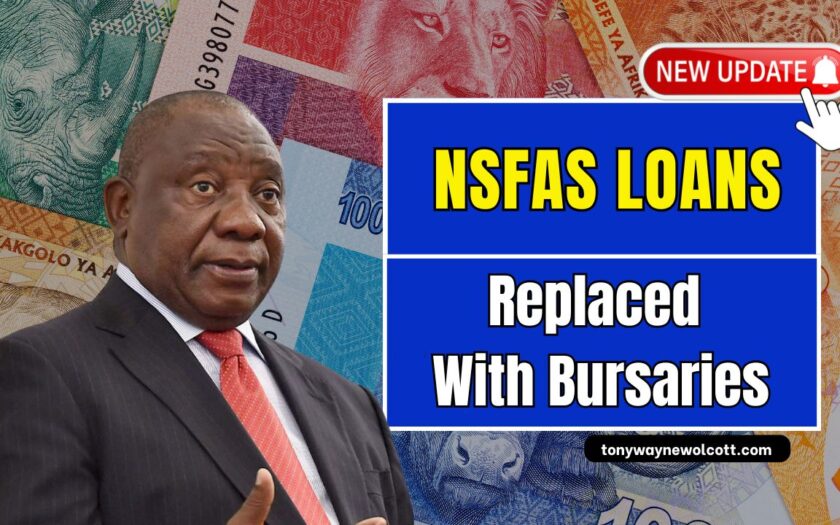If you’ve heard that NSFAS loans were “replaced” with full bursaries in 2025, that’s not quite right. What actually happened is more nuanced—and, for many students, better. In 2025, the NSFAS bursary for poor and working-class students continues, while a new, separate loan scheme was introduced to support the “missing-middle”.
What Exactly Changed in 2025?
- Bursaries remain for poor and working-class students (generally household income ≤ R350,000; ≤ R600,000 for students with disabilities). These bursaries do not require repayment and cover approved costs at public universities and TVET colleges.
- A new NSFAS loan was launched for the missing-middle (roughly R350,001–R600,000 household income). This is in addition to, not a replacement for, bursaries. Loans are repayable under set conditions.
Who Qualifies in 2025?
- NSFAS Bursary (DHET Bursary Scheme):
South African citizens (and qualifying permanent residents) enrolled at public universities/TVETs, meeting means-test criteria (≤ R350,000 household income; ≤ R600,000 with a registered disability), and satisfactory academic progress. SASSA recipients typically qualify on financial means automatically.
What Does Funding Cover in 2025?
NSFAS bursary coverage and typical annual allowance benchmarks published for 2025 include:
- Accommodation (capped to institutional or approval-based costs)
- Transport (up to R7,500 per annum for students living ≤ 40 km from campus)
- Living allowance (about R15,000 per annum at universities)
- (Programme-specific items like books/devices may apply per institutional rules)
2025 Timelines & Payments
- Allowance disbursements for early 2025 were processed in March after valid registrations, with some institutions communicating catch-up runs and phased releases into April as records were validated. If you registered later, expect staggered releases once your registration is confirmed.
Bursary vs. Loan in 2025
| Feature | NSFAS Bursary (DHET) | NSFAS Loan (Missing-Middle) |
|---|---|---|
| Primary target | Poor & working-class students | Missing-middle students |
| Income threshold | ≤ R350,000 (≤ R600,000 with disability) | R350,001–R600,000 |
| Repayment | No (subject to rules & academic progress) | Yes (loan terms apply) |
| Coverage | Accommodation, transport (≤40 km up to R7,500), living (≈ R15,000), approved learning costs | Tuition and approved costs under loan rules |
| Institution type | Public universities & TVETs | Public universities & TVETs (approved programmes) |
| Application route | NSFAS portal & institution workflows | NSFAS portal → Loan option |
| 2025 status | Ongoing | Newly added/expanded |
How to Apply (Step-by-Step)
- Create/Log in to your myNSFAS account and complete personal/household income info accurately (ID, names must match your SA ID).
- Select the right product: Bursary (if within bursary means test) or Loan (if in the R350k–R600k band).
- Upload supporting documents (ID, proof of income/SASSA, academic records, disability documents if applicable).
- Track your status (Application Received → Evaluation → Funding Eligibility → Registration/Allowance processing). Institutions share updates on their sites.
Pro tip: Submit early and double-check every document; mismatches (names/ID, outdated income proof) cause delays and rejections.
Why the 2025 Setup Matters
- It protects bursaries for the poorest students while opening doors for families who earn just above the old threshold but still can’t afford fees. Government seeded the loan scheme as part of a two-phase rollout of a broader funding model, with capitalisation to support missing-middle students.
- Universities and TVETs coordinated allowance catch-ups as registrations finalised, reducing the start-of-year shock many students faced previously.
Jargon Buster (Fast)
- Missing-middle = Households that don’t qualify for bursaries but can’t afford full cost either (≈ R350k–R600k income).
- Allowances = Living, transport, book/device (programme/institution-specific). Accommodation is paid within caps/approval rules.
No, NSFAS didn’t scrap loans in favour of only bursaries. In 2025, the NSFAS bursary for low-income students continues, and a new loan track now supports the missing-middle.
That means more coverage, clearer allowances, and broader access—but also a need to apply carefully, pick the right product, and watch your institution’s updates on registration and disbursements.
FAQs
Game-Changing 2025 Update: NSFAS Loans Replaced with Full Bursaries
No. The bursary continues for poor and working-class students. What’s new is an additional loan for the missing-middle—so both exist in 2025.
What are the typical NSFAS bursary allowances in 2025?
At universities, benchmarks include transport up to R7,500 (≤40 km) and a living allowance around R15,000 per year; accommodation follows institutional caps/approvals. Programme-specific items (books/devices) can apply. Always confirm with your institution.
When will my 2025 allowances be paid?
Payments are staggered based on valid registrations. In March 2025, NSFAS released payments covering early months, with institutions running catch-ups into April for students whose records were finalised later.

